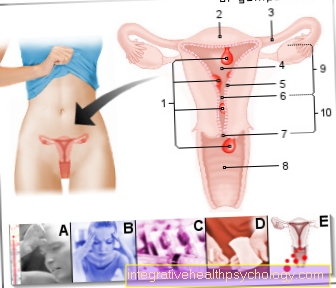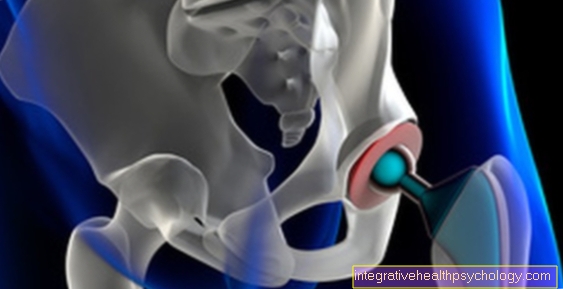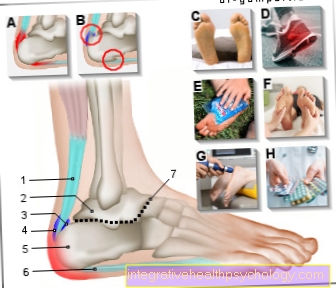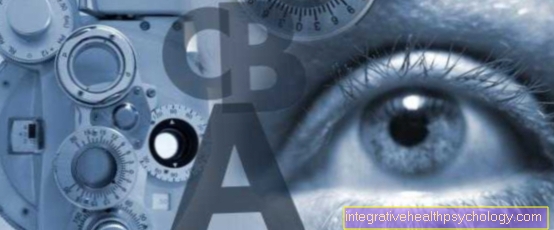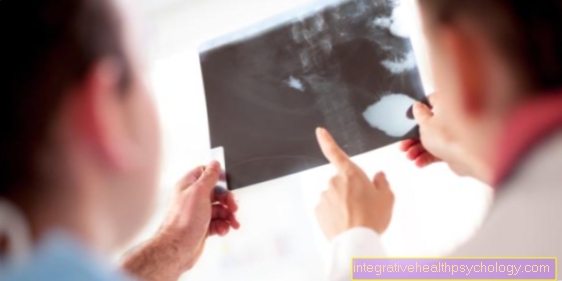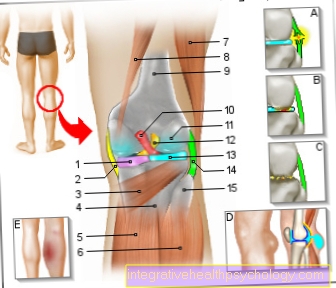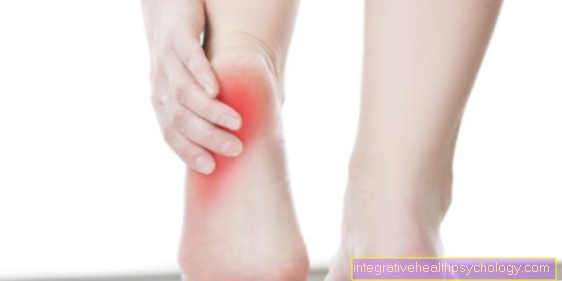Childbirth complications
introduction
A variety of complications for mother and / or child can arise during childbirth. Some of these are easy to treat, but they can also represent acute emergencies. They affect both the birth process up to the delivery of the child and the postpartum phase.

Complications for mother and child can also occur during pregnancy or shortly before birth. Reasons for this are, for example, gestational diabetes, high blood pressure in the mother or pregnancy poisoning.
Overall, complications during childbirth are rare, so most births go off without problems. Maternal deaths in connection with childbirth are extremely rare in this country.
Also read our article: The process of a birth.
Complications for the mother
Complications for the mother can arise especially during the afterbirth phase, i.e. when the child has already been born and the afterbirth (placenta, remains of the umbilical cord and egg membranes) has yet to be born. The placenta should be rejected about 10 to 30 minutes after the delivery of the child. Incomplete rejection of the afterbirth can lead to severe blood loss and, in the worst case, to circulatory failure (see below).
Please also read: Placental causes of complications during childbirth
Severe blood loss can also occur if the uterine muscles do not contract or not contract sufficiently after the birth (so-called Uterine atony). Causes for this can be an overstretching of the uterine wall (for example by very large children or multiple births) or malformations of the uterus.
A very rare but serious complication for the mother is the so-called uterine rupture, which can occur during pregnancy and during childbirth. This leads to cracks in the wall of the uterus, which are accompanied by sudden severe pain and a great deal of blood loss.
Other complications for the mother are birth injuries. These include injuries to the vagina, the labia, the vagina, the cervix, the cervix and, very rarely, the pubic symphysis (so-called Symphysis). A common birth injury is the so-called perineal tear, i.e. an injury to the skin and possibly the muscles between the vagina and the anus. These are divided into different degrees depending on size and depth and occur in around 20 to 30 percent of all births.
For more information on vaginal ruptures, we recommend our website: Vaginal tear during childbirth - can it be prevented?
In the foreground of the care of the birth injuries are hemostasis, wound cleaning and the suturing of the wound.
A very rare complication during childbirth is amniotic fluid embolism. Amniotic fluid gets into the mother's blood (mostly through birth injuries) and sudden blood clotting can lead to shortness of breath and circulatory failure.
You might also be interested in this topic: Air embolism
Complications for the child
Complications for the child occur mainly during the course of labor. Reasons for this can be the size, position or posture of the child on the one hand, or the labor and body structure of the mother on the other.
An important complication of these causes is the birth arrest, in which the birth does not progress further despite good labor (Please also read: Which CTG values are normal?). In the case of a birth arrest in the opening phase (no further opening of the cervix for a period of more than two hours), a caesarean section is performed in most cases. In the event of a birth arrest in the expulsion phase (no labor progress for more than about an hour), either a caesarean section occurs or the birth is ended with the help of a suction cup or forceps delivery.
Read more about these topics: Indications for a caesarean section and complications and risks of a caesarean section
The so-called positional anomalies of the child include the breech position (see below), the transverse or oblique position, if the child lies transversely or obliquely in relation to the birth canal. Postural anomalies describe, among other things, the position of the forehead or face when the child's head is overstretched backwards. In most cases, a caesarean section is then performed.
Problems during childbirth can also arise if the child's head does not rotate properly in the mother's pelvis. If the head does not adjust correctly despite various assistance, the birth must be ended by external intervention (suction cup, forceps or caesarean section). A so-called shoulder dystocia occurs in 0.5 to 1 percent of births and describes the condition when the child's head is already born but the shoulders are still hanging in the mother's pelvis due to the child's lack of rotation, so that the rest of the body is not born can. The risk of developing shoulder dystocia is increased in large children (over 4000 g) and represents an emergency for both mother and child.
A disturbance in labor is stressful for mother and child and can cause, among other things, an insufficient supply of oxygen to the child, a delay in the birth process or a birth arrest. The contractions can be either too weak or too strong: too little labor describes too weak contractions, too short contractions or too long pauses between the individual contractions. Too violent contractions describe too strong or too frequent contractions up to a so-called labor storm.
In addition, stress for the child during childbirth can lead to the premature loss of the so-called meconium. Kindspech is the newborn's first stool, which is usually passed within the first 48 hours after birth. Due to birth complications, such as insufficient oxygen supply to the child, the meconium can settle into the amniotic fluid during the birth process. This represents an acute threat to the child, as the amniotic fluid containing meconium can be inhaled and can lead to lung damage (Meconium aspiration syndrome).
A disproportion between the child's head and the mother's pelvis (shape and / or size do not match), a pelvis that is too narrow or a pelvic floor that is too tight can cause complications during childbirth and, among other things, lead to a birth arrest.
Further complications for the child during birth are problems with the umbilical cord. These can be, for example, umbilical cord loops and umbilical cord knots - an acute emergency is the umbilical cord prolapse (see below).
Read more on the topic: Placental insufficiency
Umbilical cord complications
Umbilical cord complications include cord looping, cord knots, and the umbilical cord prolapse. In some cases, these umbilical cord complications can already be recognized before birth or are noticeable during birth through changes in the so-called CTG (cardiotocography; recording of child's heart sounds and labor).
The umbilical cord wrapping occurs in about 20 percent of all children and describes a single or multiple wrapping of the neck with the umbilical cord. Causes for this include increased physical activity in the child or a long umbilical cord. Umbilical cord knots occur in about one percent of all births. They can also come about through increased movement of the child. The contraction of the knots during childbirth rarely results in an oxygen deficiency in the child. However, in most cases, umbilical cord loops or knots do not lead to major complications during childbirth.
The umbilical cord prolapse is an emergency. It occurs in 0.5 percent of all births and describes an entrapment of the umbilical cord between the pelvis and head after the rupture of the bladder. This can lead to a lack of oxygen in the child, which is why it is necessary to act quickly and perform an emergency caesarean section.
Read more about this: Umbilical knot
Breech complications
A breech position describes a child's position in which not the child's head, but the child's Pool end (Buttocks, feet or knees) precedes. It occurs in five percent of all births, in premature births it is around ten to 15 percent. The causes of breeches are often unclear.
A normal, vaginal birth with breeches poses many risks, especially during the first birth. For one thing is the Birth of the head difficultbecause the birth canal was insufficiently widened by the previous passage of the rump or buttocks. On the other hand it comes more often to Umbilical cord incidents and entrapment with the following oxygen deficiency in the child.
Under certain conditions is a vaginal birth possible - the The decision to do so should be weighed very carefully requires some pre-birth examinations and should take place in certain specialized centers. Mostly, however, children in breech position either become more successful after external twist vaginally born or there is a planned one Caesarean section. An external twist can be made from the 37th week of pregnancy. The attempt is made to turn the child into the correct position from the outside. It takes place under the strict supervision of mother and child.
Complications of the placenta
The placenta (placenta) represents a direct connection between mother and child, through which, among other things, oxygen and nutrients are exchanged. A misalignment of the placenta or problems with the detachment of the placenta can lead to complications before, during and after the delivery of the child.
Read more on this topic: Placental causes of complications during childbirth
The Placenta previa describes a misalignment of the placenta and occurs in 0.4 percent of all pregnancies. The placenta lies deeper in the uterus and can partially or completely cover the cervix. Serious bleeding can occur during childbirth and a caesarean section must be performed.
Premature placenta detachment, i.e.detachment of the placenta before the child is cordoned off can cause complications before or during labor. It occurs in around 0.8 percent of all pregnancies and can acutely endanger mother and child. Symptoms include a hard uterus, pain, dizziness, loss of consciousness and bleeding, and circulatory and kidney failure can occur.
Read more on this topic: Diseases of the placenta
A disruption of the placental detachment is present if the placenta has not loosened more than 30 minutes after the umbilical cord, the mother has lost more than 300 ml of blood or the afterbirth was not or only partially born. There can be different causes for this, for example that the uterine muscles do not contract enough to reject the placenta or that the placenta has grown together with the uterine wall.
Learn more at: Placental detachment after childbirth
Furthermore, a cramping of the cervix can lead to the fact that the afterbirth cannot be born. The main complications are profuse bleeding. Medicines or various manipulations are used therapeutically, in the worst case the uterus has to be surgically removed.
Read more on the topic: Afterbirth



